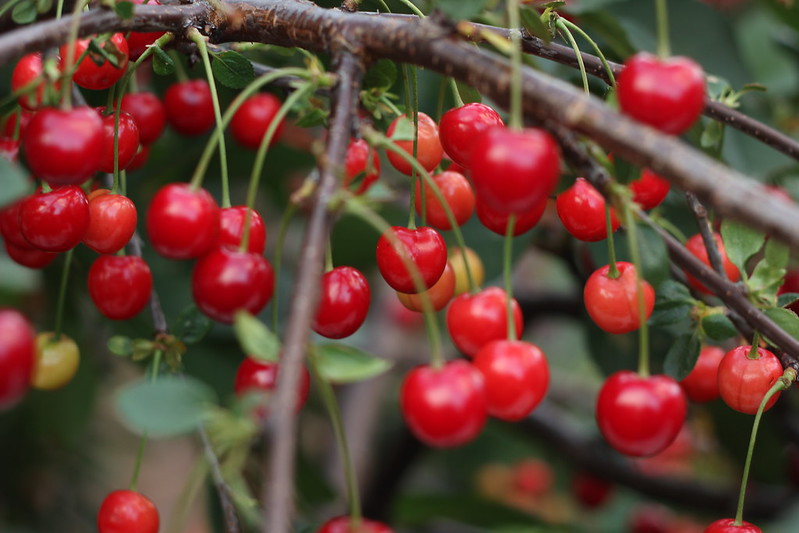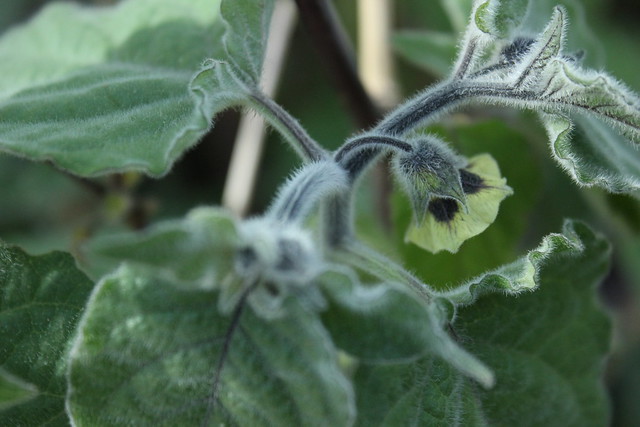 |
| ~ Looking good but not quite dark enough for Morello cherries ~ |
I have abandoned any hope of cherries this year which is ironic if you've read anything that I've written about cherries in previous years. I've banged on about how I've struggled to find a use for the Morello (sour) cherries that I grow here. Morello would not have been my first choice of cultivar but this is what I have from a group decision at the start of the veg patch. Because of the sour taste, the fruit is best used for jam making or cooking. I have one neighbour who likes to eat them raw and she usually has her pick of the crop. Not this year.
This year was different; I was actually looking forward to a huge haul of cherries! :o) I'd made cherry chutney last year, having singularly failed to make a decent jam that wasn't cloyingly sweet. I recently opened a jar of said chutney ... and, to my amazement, the taste was extremely good. Unfortunately, I'd given most of it away. No matter, I'd make some more - or would I? As it turns out, no.
Stupidly, I overlooked some crucial points. I didn't net the fruit. This followed the pattern of previous years because I've had no problems with birds eating the fruit - until now. I also failed to monitor the fruit as it ripened.
 |
| ~ Slightly shaded tree, mid-July; still plenty of unripe yellow cherries ~ |
This year the rain ensured a bumper crop, almost completely negating the 'June drop' where about a third of the fruitlets turn brown and drop from the tree. The fruit started to go from gold to pink at the beginning of July and then, in the blink of an eye, had turned red and soft. I'm used to the fruit turning a deep red before picking as it can be really tart otherwise. So I waited. Two weekends back, I caught a neighbour chatting on his mobile phone while absentmindedly picking my cherries and eating them! A request to desist was uttered in no uncertain terms.
But the cherries continued to disappear as they ripened. The next day, all the fruit was stripped from the top branches leaving the tree looking more like a cactus than a fruit tree. But I found the culprit - a huge wood pigeon flapped away from the tree as I approached. Mystery solved, but too late. A friend whose flat overlooks the garden tells me that she's seen other pigeons on the trees and ants are now enjoying the juice from any remaining fruit. So I think I'll pass, thank you.
 |
| ~ Bird damage; so many fruits fall as the birds peck ~ |
So what's the big lesson from this? I absolutely must net the cherries as soon as the fruit appears in future years! The fruit ripened from yellow to ready in just 10 days. Take your eye off the ball and you/I've had it.
For anyone who has sensibly netted their cherries and therefore has some to cook with, here's my cherry chutney recipe, taken from Beryl Wood's book 'Let's Preserve It'.
Plus a few notes on growing sour cherries for jam or a traditional American cherry pie:
- Morello cherries are incredibly easy to grow as they're self-fertile and will grow in part shade in a north facing spot.
- If you choose the right rootstock, they're also ideal for a small garden; mine are now in their seventh year and are no more than six feet tall.
- They are practically maintenance free, maybe a bit of light pruning of crossing branches and that's it.
- Watch out for baby trees from dropped stones - I pull out half a dozen tiny cherry trees every spring!


















